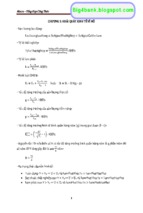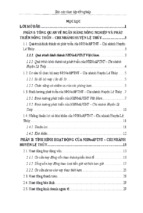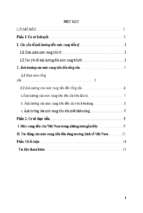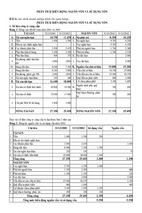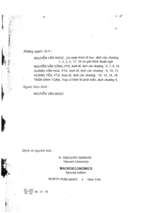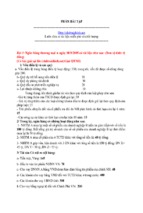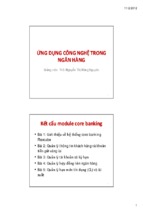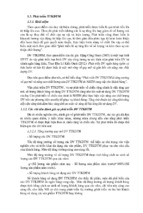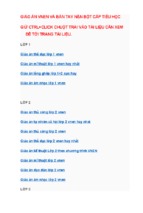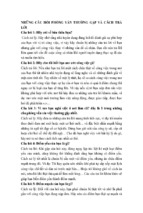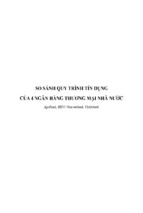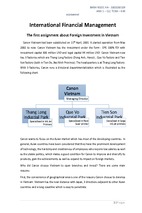1) Which of the following is a generic term that covers a broad range of feelings that people experience?
A) affect
B) emotions
C) moods
D) emotional labor
E) cognition
Answer: A
Explanation: Affect is defined as a broad range of feelings that people experience, and it encompasses both moods and emotions. Emotions are intense feelings that are directed at someone or something. Moods are feelings that tend to be less intense than emotions and that lack a contextual stimulus. Emotional labor is defined as a situation in which an employee expresses organizationally desired emotions during interpersonal transactions at work. Cognition is the mental process of thinking, learning, and knowing.
Diff: 1 Page Ref: 100
Topic: What are Emotions and Moods?
Skill: AACSB: Analytic Skills
Objective: Affect
Quest. Category: Concept/Definitional
LO: 1
2) Which of the following statements is true?
A) Affect is a type of emotion.
B) Affect is a type of mood.
C) Affect can be experienced as a mood or an emotion.
D) Affect is the result of conscious thought and action.
E) Affect is the result of a mood or an emotion.
Answer: C
Organizational Behavior, 14e (Robbins/Judge)
Chapter 6 Perception and Individual Decision Making
1) What is the process by which individuals organize and interpret their sensory impressions in
order to give meaning to their environment?
A) interpretation
B) environmental analysis
C) social verification
D) outlook
E) perception
Answer: E
Explanation: Perception is defined as a process by which individuals organize and interpret their
sensory impressions in order to give meaning to their environment. People's behavior is based on
their perception of what reality is, not on reality itself. What we perceive can be substantially
different from objective reality.
Diff: 2 Page Ref: 168-169
Topic: What Is Perception?
Skill: AACSB: Analytic Skills
Objective: Perception
Quest. Category: Concept/Definitional
LO: 1
2) What are the three classes of factors that influence perception?
A) factors in the setting, factors in the environment, and factors in the motives
B) factors in the perceiver, factors in the target, and factors in the situation
C) factors in the character, factors in knowledge, and factors in experience
D) factors in the personality, factors in the character, and factors in the values
E) factors in the senses, factors in the surroundings, and factors in the lighting
Answer: B
Explanation: Three factors operate to shape and sometimes distort perception. These factors can
reside in the perceiver; in the object, or target, being perceived; or in the context of the situation
in which the perception is made.
Diff: 2 Page Ref: 168
Topic: What Is Perception?
Skill: AACSB: Analytic Skills
Objective: Factors Influencing Perception
Quest. Category: Concept/Definitional
LO: 1
1
Copyright © 2011 Pearson Education, Inc.
3) Two people see the same thing at the same time yet interpret it differently. Where do the
factors that operate to shape their dissimilar perceptions reside?
A) the perceivers
B) the target
C) the timing
D) the context
E) the situation
Answer: A
Explanation: Because the target and the situation are the same, the difference in perception must
be in the perceivers themselves. Characteristics that can affect perception include perceiver
attitudes, personality, motives, interests, past experiences, and expectations.
Diff: 2 Page Ref: 168
Topic: What Is Perception?
Skill: AACSB: Analytic Skills
Objective: Factors Influencing Perception
Quest. Category: Concept/Definitional
LO: 1
4) Which of the following is not a factor in the individual perceiver?
A) attitude
B) motive
C) expectation
D) location
E) perception
Answer: D
Explanation: Characteristics that can affect perception include perceiver attitudes, personality,
motives, interests, past experiences, and expectations. Location is a factor in the situation, or as
background for the factor of the target.
Diff: 2 Page Ref: 168-169
Topic: What Is Perception?
Skill: AACSB: Analytic Skills
Objective: Factors Influencing Perception
Quest. Category: Concept/Definitional
LO: 1
2
Copyright © 2011 Pearson Education, Inc.
5) David has the opinion that people who drive SUVs are dangerous drivers. He often perceives
that people driving SUVs are doing so in a dangerous manner, even when other observers can
see nothing wrong with the behavior of the SUV drivers. What factor in David is affecting his
perception in this case?
A) his interests
B) his work setting
C) his expectations
D) his motives
E) his background
Answer: C
Explanation: David expects all SUV drivers to be dangerous. His expectations are what color his
perception. The example doesn't explain why he expects this, although it could be from a
previous bad experience.
Diff: 2 Page Ref: 168-169
Topic: What Is Perception?
Skill: AACSB: Analytic Skills
Objective: Factors Influencing Perception
Quest. Category: Application
LO: 1
6) Which of the following is not true about our perceptions of a target?
A) Objects that are close together will be perceived together rather than separately.
B) Persons that are similar to each other tend to be grouped together.
C) Targets are usually looked at in isolation.
D) Motion, sounds, size, and other attributes of a target shape the way we see it.
E) Objects that are distant from one another will be perceived separately rather than as a group.
Answer: C
Explanation: Characteristics of the target we observe can affect what we perceive. Targets are
not perceived in isolation/ The relationship of a target to its background influences perception, as
does our tendency to group close things and similar things together.
Diff: 2 Page Ref: 168
Topic: What Is Perception?
Skill: AACSB: Analytic Skills
Objective: Factors Influencing Perception
Quest. Category: Concept/Definitional
LO: 1
3
Copyright © 2011 Pearson Education, Inc.
7) The time at which an object or event is seen is an example of what type of factor influencing
the perceptual process?
A) perceiver
B) target
C) social
D) reality
E) context
Answer: E
Explanation: Context is important to perception. Context includes the time at which a perceiver
sees an object or event, as well as location, light, heat, or any number of situational factors.
Diff: 2 Page Ref: 168-169
Topic: What Is Perception?
Skill: AACSB: Analytic Skills
Objective: Factors Influencing Perception
Quest. Category: Concept/Definitional
LO: 1
8) Last year Elaine had her purse snatched on the street bytwo teens who wore their jeans very
low. All she can remember is seeing, as the teens ran away, was their plaid boxer shorts sticking
out above their pants. Whenever Elaine sees boys with low-riding jeans her face tightens and she
mumbles something about "delinquents". She is extremely bothered that her own grandson, an
honor student, has begun to wear his jeans low. Elaine's perception of her grandson is influenced
by ________.
A) motives
B) interests
C) setting
D) reality
E) experience
Answer: E
Explanation: Elaine's negative experience has influenced her perception, even when she knows
that the reality is different. Elaine's grandson is far from a delinquent, and yet she groups him
with the purse snatchers because of her memories of the negative experience.
Diff: 2 Page Ref: 168-169
Topic: What Is Perception?
Skill: AACSB: Analytic Skills
Objective: Factors Influencing Perception
Quest. Category: Application
LO: 1
4
Copyright © 2011 Pearson Education, Inc.
9) What is the most relevant application of perception concepts to OB?
A) the perceptions people form about each other
B) the perceptions people form about their employer
C) the perceptions people form about their culture
D) the perceptions people form about society
E) the perceptions people form about external reality
Answer: A
Explanation: In the application of perception concepts to OB, person perception, or the
perceptions people form about each other, is the most relevant. Nonliving objects such as desks,
machines, and buildings have no beliefs, motives, or intentions, but people do. Therefore, we
attempt to explain why people behave in certain ways.
Diff: 2 Page Ref: 170
Topic: Person Perception: Making Judgments About Others
Skill: AACSB: Analytic Skills
Objective: Person Perception
Quest. Category: Concept/Definitional
LO: 2
10) What is the name of the theory that deals with how we explain behavior differently
depending on the meaning we assign to the behavior of the actor?
A) behavioral theory
B) judgment theory
C) selective perception theory
D) attribution theory
E) equality theory
Answer: D
Explanation: Attribution theory is an attempt to determine whether an individual's behavior is
internally or externally caused. We judge people differently, depending on the meaning we
attribute to a given behavior. Attribution theory suggests that when we observe an individual's
behavior, we attempt to determine whether it was internally or externally caused.
Diff: 2 Page Ref: 170-171
Topic: Person Perception: Making Judgments About Others
Skill: AACSB: Analytic Skills
Objective: Attribution Theory
Quest. Category: Concept/Definitional
LO: 2
5
Copyright © 2011 Pearson Education, Inc.
11) When individuals observe another person's behavior, they attempt to determine whether it is
internally or externally caused. This phenomenon is most directly relevant to which of the
following?
A) the Pygmalion effect
B) projection theory
C) attribution theory
D) selective perception theory
E) expectancy theory
Answer: C
Explanation: Attribution theory is an attempt to determine whether an individual's behavior is
internally or externally caused. We judge people differently, depending on the meaning we
attribute to a given behavior. Attribution theory suggests that when we observe an individual's
behavior, we attempt to determine whether it was internally or externally caused.
Diff: 2 Page Ref: 170
Topic: Person Perception: Making Judgments About Others
Skill: AACSB: Analytic Skills
Objective: Attribution Theory
Quest. Category: Concept/Definitional
LO: 2
12) Which of the following is an example of externally caused behavior?
A) An employee is late because he was partying late and then overslept.
B) An employee is late because of a flat tire.
C) An employee was fired because he slept on the job.
D) An employee was promoted because he was hard working.
E) An employee died from lung cancer after excessive tobacco use.
Answer: B
Explanation: Externally caused behavior is what we imagine the situation forced the individual
to do. If an employee is late for work, and you attribute his arriving late to an automobile
accident or a flat tire, then you are making an external attribution.
Diff: 2 Page Ref: 170
Topic: Person Perception: Making Judgments About Others
Skill: AACSB: Analytic Skills
Objective: Attribution Theory
Quest. Category: Concept/Definitional
LO: 2
6
Copyright © 2011 Pearson Education, Inc.
13) What term is used for the extent to which an individual displays different behaviors in
different situations?
A) continuity
B) integrity
C) stability
D) flexibility
E) distinctiveness
Answer: E
Explanation: Distinctiveness is one of three determining factors that contribute to attribution
theory perceptions. Determining whether the behavior is different from normally expected
behavior of the target, refers to distinctiveness.
Diff: 2 Page Ref: 170
Topic: Person Perception: Making Judgments About Others
Skill: AACSB: Analytic Skills
Objective: Distinctiveness
Quest. Category: Concept/Definitional
LO: 2
14) What does consensus refer to in attribution theory?
A) There is general agreement about a perception.
B) Different people respond the same way in the same situation.
C) There is general agreement about how people desire to respond to the same situation.
D) Different people perceive a situation similarly.
E) All people behave precisely the same way in certain situations.
Answer: B
Explanation: A behavior that shows consensus is one when everyone responds the same way to
the situation. For example, if everyone who took the same route to work is late, there is high
consensus in behavior.
Diff: 2 Page Ref: 170
Topic: Person Perception: Making Judgments About Others
Skill: AACSB: Analytic Skills
Objective: Consensus
Quest. Category: Concept/Definitional
LO: 2
7
Copyright © 2011 Pearson Education, Inc.
15) Randy always turns in reports with punctuation errors. The reports of the three other
employees on the QA report writing team always produce grammatically clean reports. Randy is
about to turn in another report, and his manager has already noticed errors. Randy demonstrates
________. His sloppy reports can be attributed to an ________ cause.
A) low distinctiveness, low consensus, and high consistency; internal
B) high distinctiveness, low consensus, and high consistency; external
C) low distinctiveness, high consensus, and high consistency; internal
D) low distinctiveness, low consensus, and high consistency; external
E) high distinctiveness, high consensus, and high consistency; internal
Answer: A
Explanation: Randy's behavior is not different from previous behavior, demonstrating low
distinctiveness. His reports are different from the other reports of the team, showing low
consensus. His next report is the same as his previous work, showing high consistency of poor
work quality. Therefore, Randy's poor work could be perceived as coming from an internal
cause, probably his own carelessness and lack of conscientious work ethic.
Diff: 2 Page Ref: 170
Topic: Person Perception: Making Judgments About Others
Skill: AACSB: Analytic Skills
Objective: Consensus
Quest. Category: Application
LO: 2
16) If a person responds the same way over time, attribution theory states that the behavior
shows ________.
A) distinctiveness
B) consensus
C) consistency
D) continuity
E) stability
Answer: C
Explanation: Consistency in a person's actions means that the person responds the same way over
time to the same situation. An employee who hasn't been late for several months is perceived
differently than an employee who is late two or three times a week. The regularly late employee
demonstrates high consistency in tardiness.
Diff: 2 Page Ref: 170
Topic: Person Perception: Making Judgments About Others
Skill: AACSB: Analytic Skills
Objective: Consistency
Quest. Category: Concept/Definitional
LO: 2
8
Copyright © 2011 Pearson Education, Inc.
17) Janice is late for work each day by about ten minutes. How would attribution theory describe
this behavior?
A) It shows consensus.
B) It shows similarity.
C) It shows reliability.
D) It shows consistency.
E) It shows distinctiveness.
Answer: D
Explanation: Consistency in a person's actions means that the person responds the same way over
time to the same situation. An employee who hasn't been late for several months is perceived
differently than an employee who is late two or three times a week. Janice demonstrates high
consistency in tardiness.
Diff: 2 Page Ref: 170
Topic: Person Perception: Making Judgments About Others
Skill: AACSB: Analytic Skills
Objective: Consistency
Quest. Category: Application
LO: 2
18) The more consistent a behavior, the more the observer is inclined to ________.
A) attribute it to interpretation
B) attribute it to internal causes
C) attribute it to consensus
D) attribute it to external causes
E) attribute it to distinctiveness
Answer: B
Explanation: If a person behaves in the same way all the time, they are demonstrating high
consistency, which is considered to be propelled by internal causes. The person is making the
internal effort to be consistent, rather than be influenced by external causes.
Diff: 2 Page Ref: 170-171
Topic: Person Perception: Making Judgments About Others
Skill: AACSB: Analytic Skills
Objective: Consistency
Quest. Category: Application
LO: 2
9
Copyright © 2011 Pearson Education, Inc.
19) What term is used for the tendency to underestimate the influence of external factors and
overestimate the influence of internal factors when making judgments about the behavior of
others?
A) fundamental attribution error
B) self-serving bias
C) selective perception
D) consistency
E) actor bias
Answer: A
Explanation: Errors and biases distort attributions. When a person makes judgments about the
behavior of other people, he tends to underestimate the influence of external factors and
overestimate the influence of internal or personal factors. This is called fundamental attribution
error.
Diff: 2 Page Ref: 170-171
Topic: Person Perception: Making Judgments About Others
Skill: AACSB: Analytic Skills
Objective: Fundamental Attribution Error
Quest. Category: Concept/Definitional
LO: 2
20) Your boss never gives you the benefit of the doubt. When you arrived late from lunch, he
assumed that you had simply taken too much time. He never considered that the elevators were
out and you had to walk up 10 flights of stairs. Your boss is guilty of ________.
A) self-serving bias
B) selective perception
C) fundamental attribution error
D) inconsistency
E) stereotyping
Answer: C
Explanation: Your boss has underestimated the influence of external factors and overestimated
the influence of internal or personal factors. He is sure that your late arrival is caused by your
own efforts, or lack thereof. This is called fundamental attribution error.
Diff: 2 Page Ref: 170-171
Topic: Person Perception: Making Judgments About Others
Skill: AACSB: Analytic Skills
Objective: Fundamental Attribution Error
Quest. Category: Application
LO: 2
10
Copyright © 2011 Pearson Education, Inc.
21) What term is used for the tendency of an individual to attribute his own successes to internal
factors while putting the blame for failures on external factors?
A) fundamental attribution error
B) self-serving bias
C) consistency
D) selective perception
E) stereotyping
Answer: B
Explanation: Individuals and organizations tend to attribute their own successes to internal
factors such as ability or effort, and place the blame for failure on external factors such as bad
luck or unproductive co-workers. This is called a self-serving bias.
Diff: 2 Page Ref: 171
Topic: Person Perception: Making Judgments About Others
Skill: AACSB: Analytic Skills
Objective: Self-Serving Bias
Quest. Category: Concept/Definitional
LO: 2
22) Whenever Jane is successful she takes full credit for what has happened, but whenever she is
unsuccessful she attributes her failure to bad luck or blames one of her fellow employees. She is
guilty of ________.
A) fundamental attribution error
B) attribution bias
C) the halo effect
D) distinctiveness
E) self-serving bias
Answer: E
Explanation: Individuals and organizations tend to attribute their own successes to internal
factors such as ability or effort, and place the blame for failure on external factors such as bad
luck or unproductive co-workers. This is called a self-serving bias.
Diff: 2 Page Ref: 171
Topic: Person Perception: Making Judgments About Others
Skill: AACSB: Analytic Skills
Objective: Self-Serving Bias
Quest. Category: Application
LO: 2
11
Copyright © 2011 Pearson Education, Inc.
23) Investors bragged about their investing expertise during the stock market rally between 1996
and early 2000. Knowing individuals rely on the self-serving bias to explain failure, which of the
following explanations would an investor be most likely to state after the market imploded in
2000?
A) The Federal Reserve did all they could.
B) The analysts did not look at the numbers properly.
C) I really should have seen it coming.
D) My broker advised me to pull out, but I was blind.
E) I really should have been diversifying my earnings.
Answer: B
Explanation: The self-serving bias places the blame for failure on external factors such as bad
luck or unproductive co-workers, rather than taking personal responsibility for the failure.
Therefore, the investor is likely to blame the analysts for not looking at the numbers properly. In
each of the other choices the investor either assumes responsibility for his losses, or does not
blame others.
Diff: 2 Page Ref: 171
Topic: Person Perception: Making Judgments About Others
Skill: AACSB: Analytic Skills
Objective: Self-Serving Bias
Quest. Category: Application
LO: 2
24) Shortcuts in judging others include all of the following except ________.
A) stereotyping
B) halo effect
C) projection
D) self-serving bias
E) the Pygmalion effect
Answer: D
Explanation: Self-serving bias, the tendency for individuals to attribute their own successes to
internal factors and put the blame for failures on external factors, is not included in the shortcuts
for judging people.
Diff: 2 Page Ref: 171-174
Topic: Frequently Used Shortcuts in Judging Others
Skill: AACSB: Analytic Skills
Objective: Shortcuts in Judging Others
Quest. Category: Concept/Definitional
LO: 3
12
Copyright © 2011 Pearson Education, Inc.
25) Because it is impossible for us to assimilate everything we perceive, we engage in ________.
A) selective perception
B) memorization
C) mental desensitization
D) periodic listening
E) linear clustering
Answer: A
Explanation: The tendency to take in bits and pieces, and to take more notice of an object or
event because it stands out due to a person's interests, background, experience, and attitudes., is
called selective perception. Selective perception occurs because it is impossible for a person to
assimilate everything he sees; he can take in only certain stimuli.
Diff: 2 Page Ref: 171
Topic: Frequently Used Shortcuts in Judging Others
Skill: AACSB: Analytic Skills
Objective: Selective Perception
Quest. Category: Concept/Definitional
LO: 3
26) A committee is made up of 12 managers: three each from the sales, production, accounting,
and human resources departments. They read a comprehensive study of the company they work
for, and are asked which of its recommendations are most important. In discussion they find that
the managers perceive that the most important recommendations are those concerning their own
departments. This finding is most likely the result of what type of bias?
A) selective perception
B) halo effect
C) Pygmalion effect
D) self-serving bias
E) projection
Answer: A
Explanation: The managers' behavior is an example of how vested interests can significantly
influence the problems a person sees, which is a form of selective perception. The managers
perceived as important the aspects of a situation specifically related to their own unit's activities
and goals.
Diff: 3 Page Ref: 172
Topic: Frequently Used Shortcuts in Judging Others
Skill: AACSB: Analytic Skills
Objective: Selective Perception
Quest. Category: Application
LO: 3
13
Copyright © 2011 Pearson Education, Inc.
27) What is the term used for a general impression about an individual based on a single
characteristic such as intelligence, sociability, or appearance?
A) contrast effects
B) personal bias
C) prejudice
D) the halo effect
E) projection
Answer: D
Explanation: When we draw a general impression about an individual on the basis of a single
characteristic, such as intelligence, sociability, or appearance, a halo effect is operating. A single
trait is allowed to influence the overall impression of the person being judged.
Diff: 2 Page Ref: 173
Topic: Frequently Used Shortcuts in Judging Others
Skill: AACSB: Analytic Skills
Objective: The Halo Effect
Quest. Category: Concept/Definitional
LO: 3
28) It's Marisol's first day on a new job. At first she was very nervous, but when she was
introduced to her cubicle neighbor, Hanna, she was taken aback by Hanna's soothing smile.
Marisol knew that a person with such a beautiful smile could not be bad, and that she would
enjoy having her in such close proximity.
A) contrast effects
B) prototyping
C) the halo effect
D) selective perception
E) profiling
Answer: C
Explanation: The halo effect is the tendency to draw a general impression about an individual on
the basis of a single characteristic. Marisol is judging Hanna based only on her smile, without
getting to know any other details.
Diff: 2 Page Ref: 173
Topic: Frequently Used Shortcuts in Judging Others
Skill: AACSB: Analytic Skills
Objective: The Halo Effect
Quest. Category: Application
LO: 3
14
Copyright © 2011 Pearson Education, Inc.
29) Your rating in a job interview is high in contrast to the candidate who was interviewed
directly before you, who was rated extremely low. Your own high rating might be partially
attributed to which of the following?
A) the halo effect
B) contrast effects
C) projection
D) stereotyping
E) prototyping
Answer: B
Explanation: Contrast effect is the evaluation of a person's characteristics that is affected by
comparisons with other people recently encountered who rank higher or lower on the same
characteristics. The high score in the interview may be attributed to this effect.
Diff: 2 Page Ref: 173
Topic: Frequently Used Shortcuts in Judging Others
Skill: AACSB: Analytic Skills
Objective: Contrast Effects
Quest. Category: Concept/Definitional
LO: 3
30) One of the shortcuts used to judge others involves evaluating a person based on how he/she
compares to other individuals on the same characteristic. What is this shortcut called?
A) selective perception.
B) contrast effects
C) the halo effect
D) prejudice
E) stereotyping
Answer: B
Explanation: Contrast effect is the evaluation of a person's characteristics that is affected by
comparisons with other people recently encountered who rank higher or lower on the same
characteristics. The high score in the interview may be attributed to this effect.
Diff: 2 Page Ref: 173
Topic: Frequently Used Shortcuts in Judging Others
Skill: AACSB: Analytic Skills
Objective: Contrast Effects
Quest. Category: Concept/Definitional
LO: 3
15
Copyright © 2011 Pearson Education, Inc.
31) What do we call it when we judge someone on the basis of our perception of the group to
which he/she belongs?
A) grouping
B) stereotyping
C) categorizing
D) assimilating
E) prototyping
Answer: B
Explanation: Stereotyping is defined as judging someone on the basis of one's perception of the
group to which that person belongs. Relying on this type of generalizations helps a person make
decisions quickly. They are a means of simplifying a complex world.
Diff: 2 Page Ref: 173-174
Topic: Frequently Used Shortcuts in Judging Others
Skill: AACSB: Analytic Skills
Objective: Stereotyping
Quest. Category: Concept/Definitional
LO: 3
32) When F. Scott Fitzgerald said, "The very rich are different from you and me," and
Hemingway replied, "Yes, they have more money," Hemingway refused to engage in what
shortcut to judge others?
A) projection
B) contrast effect
C) halo effect
D) stereotyping
E) prototyping
Answer: D
Explanation: Stereotyping is defined as judging someone on the basis of one's perception of the
group to which that person belongs. Fitzgerald was stereotyping the rich, but Hemingway
refused to engage in the stereotype.
Diff: 2 Page Ref: 173-174
Topic: Frequently Used Shortcuts in Judging Others
Skill: AACSB: Analytic Skills
Objective: Stereotyping
Quest. Category: Application
LO: 3
16
Copyright © 2011 Pearson Education, Inc.
33) Which of the following statements is not an example of stereotyping?
A) There is no need to offer child-care to him; men aren't interested in child care.
B) Don't hire an older worker; they can't learn new skills.
C) She was good at her last job, so she will be good at this one.
D) She won't relocate for a promotion, since women don't relocate.
E) The new hire will be emotionally insensitive, since he is a man.
Answer: C
Explanation: Stereotyping is judging someone on the basis of one's perception of the group to
which that person belongs. Judging a person by her last job is judging her experience. In each of
the other examples the speaker judges based on a collective group.
Diff: 2 Page Ref: 173-174
Topic: Frequently Used Shortcuts in Judging Others
Skill: AACSB: Analytic Skills
Objective: Stereotyping
Quest. Category: Concept/Definitional
LO: 3
34) Leone thinks that because her employee, Josef, went to an Ivy League college he is very
knowledgeable, and always asks his opinion on the firm's investments. In reality, Josef knows
very little about investing, but makes sure he reads up on it so that he can give an informed
opinion to Leone. What has occurred in this situation?
A) profiling
B) a self-fulfilling prophecy
C) a self-serving bias
D) the fundamental attribution error
E) a projection event
Answer: B
Explanation: Josef's behavior is determined by Leone's expectations. When expectations become
reality it is a self-fulfilling prophecy.
Diff: 2 Page Ref: 175
Topic: Frequently Used Shortcuts in Judging Others
Skill: AACSB: Analytic Skills
Objective: Self-Fulfilling Prophecy
Quest. Category: Application
LO: 3
17
Copyright © 2011 Pearson Education, Inc.
35) What is another name for a self-fulfilling prophecy?
A) Pygmalion effect
B) projection
C) self-selecting bias
D) halo effect
E) prototyping
Answer: A
Explanation: The terms self-fulfilling prophecy and Pygmalion effect describe how an
individual's behavior is determined by others' expectations.
Diff: 2 Page Ref: 175
Topic: Frequently Used Shortcuts in Judging Others
Skill: AACSB: Analytic Skills
Objective: Self-Fulfilling Prophecy
Quest. Category: Concept/Definitional
LO: 3
36) Shortcuts in judging people are applied in organizations. Which of the following is not an
application of a judgement shortcut?
A) performance evaluations
B) setting high expectations
C) unwittingly maintaining low expectations
D) employment interviews
E) market evaluations
Answer: E
Explanation: Employment interviews, performance expectations (high and low), and
performance evaluations, are all applications of shortcuts in judging people in an organization.
Diff: 2 Page Ref: 174-175
Topic: Frequently Used Shortcuts in Judging Others
Skill: AACSB: Analytic Skills
Objective: Shortcuts in Judging Others
Quest. Category: Application
LO: 3
18
Copyright © 2011 Pearson Education, Inc.
37) Why is decision making a perceptual issue?
A) Decisions must be made on how to move from the current state of affairs to some desired
state.
B) Middle and lower level managers may have different perceptions on how to solve a problem
than their underlings or top level managers.
C) Decision making is generally by consensus.
D) There may be more than one way to solve a problem.
E) Before a decision is made, a problem must be perceived to exist.
Answer: E
Explanation: Decision making occurs as a reaction to a problem, or a discrepancy between the
current state of affairs and some desired state. Decision making becomes perceptual, because one
person's problem is another person's satisfactory state of affairs. First a problem must be
perceived to exist.
Diff: 2 Page Ref: 175-176
Topic: The Link Between Perception and Individual Decision Making
Skill: AACSB: Analytic Skills
Objective: Perception and Decision Making
Quest. Category: Concept/Definitional
LO: 4
38) A discrepancy between the current state of affairs and some desired state is a ________.
A) decision
B) self-fulfilling prophecy
C) problem
D) expectation
E) stereotype
Answer: C
Explanation: A problem, or a discrepancy between the current state of affairs and some desired
state is the catalyst for decision making. Decision making occurs as a reaction to a problem.
Diff: 2 Page Ref: 175-176
Topic: The Link Between Perception and Individual Decision Making
Skill: AACSB: Analytic Skills
Objective: Perception and Decision Making
Quest. Category: Concept/Definitional
LO: 4
19
Copyright © 2011 Pearson Education, Inc.
39) What is the first step in the rational decision-making model?
A) developing alternatives
B) defining the problem
C) identifying the decision criteria
D) weighing the decision criteria
E) collecting relevant data
Answer: B
Explanation: The rational decision-making model follows a six-step process. The steps are: 1)
Define the problem; 2) Identify the decision criteria; 3) Allocate weights to the criteria; 4)
Develop the alternatives; 5) Evaluate the alternatives; 6) Select the best alternative.
Diff: 2 Page Ref: 176-177
Topic: Decision-Making in Organizations
Skill: AACSB: Analytic Skills
Objective: Rational Decision-Making Model
Quest. Category: Concept/Definitional
LO: 5
40) Mel has exceeded her budget by at least $200 every month for the last three months. After
recognizing that this is a problem, she decides to use the rational decision-making model to
decide what to do. What might be the next step she takes if she follows this model?
A) determine what she needs to take into account when making her decision
B) choose a method to cut her expenses
C) weigh the relative importance of each of her expenses
D) come up with different ways that would either reduce her expenses or increase her income
E) evaluate different ways that she could use to either reduce her expenses or increase her
income
Answer: A
Explanation: The rational decision-making model follows a six-step process. The steps are: 1)
Define the problem; 2) Identify the decision criteria; 3) Allocate weights to the criteria; 4)
Develop the alternatives; 5) Evaluate the alternatives; 6) Select the best alternative. Mel needs to
apply step two by determining the decision criteria, or what she needs to take into account.
Diff: 2 Page Ref: 176-177
Topic: Decision-Making in Organizations
Skill: AACSB: Analytic Skills
Objective: Rational Decision-Making Model
Quest. Category: Application
LO: 5
20
Copyright © 2011 Pearson Education, Inc.
- Xem thêm -

